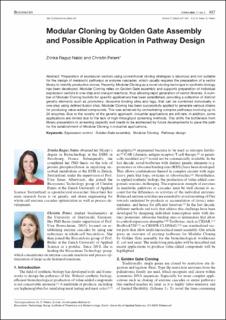Bitte benutzen Sie diese Kennung, um auf die Ressource zu verweisen:
https://doi.org/10.21256/zhaw-29951| Publikationstyp: | Beitrag in wissenschaftlicher Zeitschrift |
| Art der Begutachtung: | Peer review (Publikation) |
| Titel: | Modular cloning by Golden Gate assembly and possible application in pathway design |
| Autor/-in: | Raguz Nakic, Zrinka Peters, Christin |
| et. al: | No |
| DOI: | 10.2533/chimia.2023.437 10.21256/zhaw-29951 |
| Erschienen in: | Chimia |
| Band(Heft): | 77 |
| Heft: | 6 |
| Seite(n): | 437 |
| Seiten bis: | 441 |
| Erscheinungsdatum: | 28-Jun-2023 |
| Verlag / Hrsg. Institution: | Swiss Chemical Society |
| ISSN: | 0009-4293 |
| Sprache: | Englisch |
| Schlagwörter: | Expression control; Golden Gate assembly; Modular cloning; Pathway design; Binding sites; Promoter regions, genetic; Cloning, molecular; High-throughput screening assay; Synthetic biology |
| Fachgebiet (DDC): | 572: Biochemie 660.6: Biotechnologie |
| Zusammenfassung: | Preparation of expression vectors using conventional cloning strategies is laborious and not suitable for the design of metabolic pathways or enzyme cascades, which usually requires the preparation of a vector library to identify productive clones. Recently, Modular Cloning as a novel cloning technique in synthetic biology has been developed. Modular Cloning relies on Golden Gate assembly and supports preparation of individual expression vectors in one-step and one-pot reactions, thus allowing rapid generation of vector libraries. A number of Modular Cloning toolkits for specific applications has been established, providing a collection of distinct genetic elements such as promoters, ribosome binding sites and tags, that can be combined individually in one-step using defined fusion sites. Modular Cloning has been successfully applied to generate various strains for producing value-added compounds. This was achieved by orchestrating complex pathways involving up to 20 enzymes. Due to the novelty of the genetic approach, industrial applications are still rare. In addition, some applications are limited due to the lack of high-throughput screening methods. This shifts the bottleneck from library preparation to screening capacity and needs to be addressed by future developments to pave the path for the establishment of Modular Cloning in industrial applications. |
| URI: | https://digitalcollection.zhaw.ch/handle/11475/29951 |
| Volltext Version: | Publizierte Version |
| Lizenz (gemäss Verlagsvertrag): | CC BY 4.0: Namensnennung 4.0 International |
| Departement: | Life Sciences und Facility Management |
| Organisationseinheit: | Institut für Chemie und Biotechnologie (ICBT) |
| Publiziert im Rahmen des ZHAW-Projekts: | Plasmid-Toolbox für Enzymkaskaden |
| Enthalten in den Sammlungen: | Publikationen Life Sciences und Facility Management |
Dateien zu dieser Ressource:
| Datei | Beschreibung | Größe | Format | |
|---|---|---|---|---|
| 2023_RaguzNakic-Peters_Modular-Cloning-by-Golden-Gate-assembly.pdf | 277.43 kB | Adobe PDF |  Öffnen/Anzeigen |
Zur Langanzeige
Raguz Nakic, Z., & Peters, C. (2023). Modular cloning by Golden Gate assembly and possible application in pathway design. Chimia, 77(6), 437–441. https://doi.org/10.2533/chimia.2023.437
Raguz Nakic, Z. and Peters, C. (2023) ‘Modular cloning by Golden Gate assembly and possible application in pathway design’, Chimia, 77(6), pp. 437–441. Available at: https://doi.org/10.2533/chimia.2023.437.
Z. Raguz Nakic and C. Peters, “Modular cloning by Golden Gate assembly and possible application in pathway design,” Chimia, vol. 77, no. 6, pp. 437–441, Jun. 2023, doi: 10.2533/chimia.2023.437.
RAGUZ NAKIC, Zrinka und Christin PETERS, 2023. Modular cloning by Golden Gate assembly and possible application in pathway design. Chimia. 28 Juni 2023. Bd. 77, Nr. 6, S. 437–441. DOI 10.2533/chimia.2023.437
Raguz Nakic, Zrinka, and Christin Peters. 2023. “Modular Cloning by Golden Gate Assembly and Possible Application in Pathway Design.” Chimia 77 (6): 437–41. https://doi.org/10.2533/chimia.2023.437.
Raguz Nakic, Zrinka, and Christin Peters. “Modular Cloning by Golden Gate Assembly and Possible Application in Pathway Design.” Chimia, vol. 77, no. 6, June 2023, pp. 437–41, https://doi.org/10.2533/chimia.2023.437.
Alle Ressourcen in diesem Repository sind urheberrechtlich geschützt, soweit nicht anderweitig angezeigt.